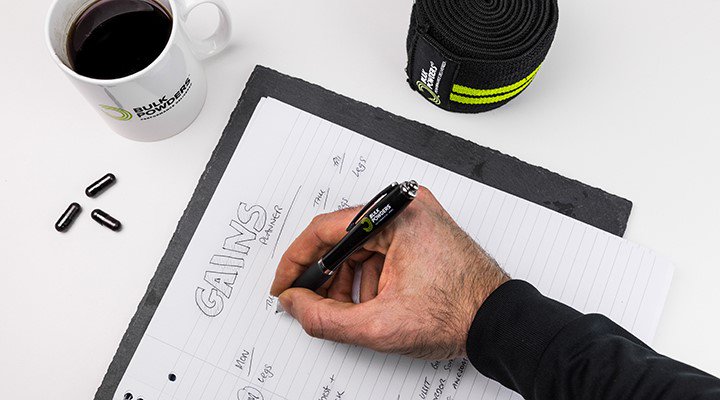The time when everyone is trying to stick to their New Year’s resolutions to get back into shape, get their beach-bodies back and get summer ready! It’s when we decide to make those “fresh starts” with our diets and start smashing those workouts. We don’t always follow through though, and it’s almost always due to one thing; there was no plan!
Whatever your goal may be; weight loss, bodybuilding or just improving your overall fitness, you need a plan to achieve it.
I assume most people reading this are already interested in weightlifting in some form or another but need a little boost to get back in beast mode.
WHY YOU NEED A PLAN
- Structure – A training plan provides you with a clear cut path to achieve your goal by giving your workouts a structure that can be easily adhered to. It also ensures you are training your entire body as opposed to merely what you can see in the mirror. Ever see those guys whose chests are so built that they need an extra seat on the train yet they can’t even do a pull up? That is because we commonly neglect the body parts we can’t see in the mirror such as our back or rear delts. A solid plan targets your entire body, leading to increased overall strength and improved aesthetic balance.
- Motivation – Following a plan reinforces your own self-confidence and self-belief system, conferring optimism and positivity into your workouts which motivates you to stick to your plan. When you finish your week’s workout plan, you can look back and say “Yeah, I killed it this week!” there is a sense of achievement which is, in itself, motivating. It’s a not-so vicious cycle that leads to all kinds of gains – both mentally and physically!
- Quantifiable Progress – A consistently followed plan that involves specific exercises each week allows you to measure progress objectively by simply noting when you have lifted more weight or performed more repetitions. If you are constantly changing your training plan, it becomes difficult to measure progress which can eventually lead to you just giving up out of frustration. Changing things up every once in a while is perfectly fine (we all get bored!) but ensuring you stick with a few key movements each week allows you to really see that progress which is another strong motivator. There are some handy apps available to track your workout progress such as FitNotes and Jefit; my personal favourites.
HOW TO PLAN TO PROGRESS
Every training plan revolves around three central points; Progressive Overload, Recovery and Good Nutrition.
Obviously, everyone will have different goals and therefore slightly different plans but the most basic and effective method to build muscle and strength is the classic four-day split centred around the most important compound movements; Overhead Press and Bench Press (upper body days) and Deadlift and Squat (lower body days). If your goal is to reduce body fat, just throw in a few 45 minute cardio sessions per week in addition to your weight training.
This training plan is simple to follow and easily customised to match your specific goals and athletic ability. Each workout begins with the compound exercise which is performed “powerlifting style”; low repetitions (5-8 sets of 3-5 reps) and high weight (≈75%+ of your 1 rep max). This is the strength training aspect of your training plan and will be the most accurate way to track your progress.
The remainder of your workout consists of 3-5 accessory or “bodybuilding” movements. The accessory movements are those that will both assist your compound movement (such as a Romanian Deadlift will help with your Squat) and if kept within the 6-12 rep range will promote muscle growth.
If you’re unsure about which accessory movements to choose a simple YouTube search will give you plenty of options but a few I highly recommend are paused squats, hip thrusts, floor press and incline dumbbell bench press which will assist your Squat, Deadlift, Bench and Overhead Press respectively.
PROGRESSIVE OVERLOAD IS KEY
Now that you have your weekly workout planned, you now need to plan Progressive Overload: a gradual increase in intensity over a period of time – usually four to six weeks. Each week, try and increase the weight you lift for your compound movement (by about 5% of your 1RM, or about 2kg) and if possible, increase the weight and/or reps of your accessory movements, too.
Sample Squat Progression:
| Exercise | Week 1 | Week 2 | Week 3 | Week 4 | Week 5 |
|---|---|---|---|---|---|
| Deadlift | 5×5 @ 70kg | 5×4 @ 72.5kg | 6×3 @ 75kg | 6×2 @ 77.5kg | 5×5 @ 65kg |
This gradual increase in intensity over time will build strength, size and confidence as you become more efficient at performing the movements. If you cannot increase the weight one week – don’t panic. This happens to everybody as progress is not always linear, so just drop the weight if your form is slipping and aim to hit it the following week!
REST AND RECOVERY
Do not neglect your rest days! I admit I am 100% guilty of not taking enough rest days and “pushing through” the fatigue just to get another workout in but do not get into this habit! There are three rest days in this plan making it perfect for those just starting off or getting back into the swing of things. Your body NEEDS rest days in order to recover from the stress imposed on it during your workouts. A tired body is not a strong body!
In addition to scheduled rest days, you MUST have a planned “deload” week. These are weeks where you drop the weight considerably on all of your exercises in order to give your body and central nervous system a break from the stress induced from weeks of intense weight lifting. These are absolutely crucial to any training plan and if ignored will eventually cause your progress to plateau or even regress, so be sure to plan these in every 4-5 weeks!
TAKE HOME MESSAGE
This year stick to your word. If you want to get back on track with your lifting or are just starting out, you know how to do it.
It takes time to build strength and muscle so be patient, make a plan and stick to it – this is how you become a beast.
Also: carbs help. Just saying!

